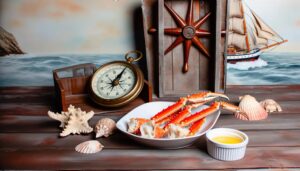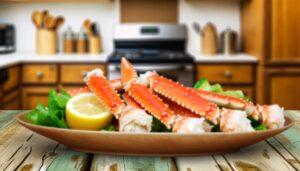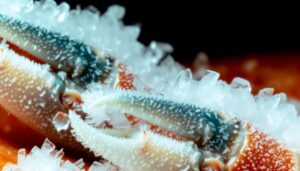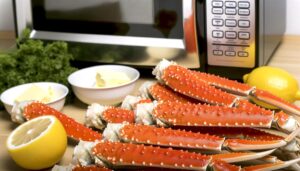Can You Eat Blue Crab Raw Safely?
You can eat most of a snow crab, Chionoecetes opilio, including its leg and body meat. Avoid eating the gills, intestines, and carapace, as these parts lack nutritional value.
Verify the crab is fresh with a firm texture and intact exoskeleton. Cook by boiling or steaming until an internal temperature of 145°F (63°C) is reached.
Use a crab cracker and seafood fork for efficient meat extraction. Enhance the experience with various dipping sauces and seasonings.
Snow crab is a low-calorie, high-protein food rich in omega-3 fatty acids. For a deeper understanding of preparation and benefits, explore further.

Key Takeaways
- Yes, you can eat a whole snow crab, but only the meat inside the shell is edible.
- Extract meat from the legs, claws, and body while avoiding the gills, carapace, and intestines.
- Use tools like a crab cracker and seafood fork to access all edible parts efficiently.
- Ensure the crab is fully cooked to an internal temperature of 145°F (63°C) for safe consumption.
- Enhance the eating experience with dipping sauces and seasonings like garlic butter or lemon herb dip.
Anatomy of a Snow Crab
Do you know how the anatomy of a snow crab is intricately designed to thrive in its cold, marine habitat?
The snow crab, Chionoecetes opilio, possesses a robust exoskeleton made of chitin, which not only provides protection but also reduces heat loss in frigid waters.
Its ten limbs, including chelae (claws), are highly adapted for scavenging and defense.
Hemolymph, acting like blood, circulates through an open circulatory system, efficiently transporting nutrients and oxygen.
Gills located under the carapace facilitate respiration, extracting oxygen from seawater.
Sensory adaptations, such as compound eyes and antennae, enable the crab to detect predators and prey with precision.
Understanding this anatomy highlights the snow crab's evolutionary success in surviving harsh marine environments.
Selecting a Fresh Crab
When choosing a fresh snow crab, examine the carapace for a bright, firm texture, indicating its health and quality. A robust, unblemished carapace suggests the crab hasn't been exposed to harmful environments.
Check for an intact exoskeleton, free from cracks or damage, which guarantees it's been handled properly. The legs should feel heavy and full, as this indicates a high meat content.
Smell the crab; it should emit a fresh, oceanic scent, not an ammonia or fishy odor, signaling spoilage. The eyes should be clear and not sunken, reflecting liveliness.
Lastly, make sure the crab is moving slightly if alive, as lethargy can indicate poor health. Following these guidelines guarantees you're selecting a top-quality snow crab.
Preparing the Crab for Cooking
To prepare the snow crab for cooking, start by thoroughly rinsing it under cold running water to remove any debris or residual sand.
Next, you'll need to humanely dispatch the crab if it's still alive. Position the crab on its back and use a sharp knife to quickly sever the central nerve. This method minimizes stress and preserves meat quality.
Afterward, remove the gills, also known as 'dead man's fingers,' which aren't edible. Carefully detach the carapace (the shell) from the body by lifting it at the rear hinge.
You should then clean the internal cavity, ensuring no remaining viscera. This preparation guarantees your snow crab is ready for best culinary application, enhancing both taste and safety.
Boiling and Steaming Methods
For best flavor and texture, boiling and steaming are two highly effective methods for cooking snow crab. When boiling, immerse the crab in a large pot of salted water, maintaining a rolling boil for 10-12 minutes. This method guarantees even heat distribution, breaking down connective tissues for tender meat.
Steaming, on the other hand, employs moist heat, preserving more flavor and nutrients. Place the crab in a steaming basket over boiling water, making sure it doesn't touch the water. Steam for 15-18 minutes, allowing the gentle heat to permeate the crab's shell.
Both methods should achieve an internal temperature of 145°F (63°C), ensuring safe consumption. These techniques enhance the snow crab's natural sweetness and succulent texture.
Tools You'll Need
You'll need a crab cracker to efficiently break open the hard exoskeleton of the snow crab, ensuring minimal damage to the delicate meat.
Using a seafood fork allows you to extract meat from narrow crevices, enhancing yield.
Additionally, a bowl for shells is essential to maintain an organized workspace and facilitate disposal.
Crab Cracker Necessity
Utilizing a crab cracker is crucial for efficiently breaking through the hard exoskeleton of a snow crab to access the tender meat inside. The robust structure of a snow crab's carapace requires specialized tools to avoid hand fatigue and guarantee meat extraction without fragmentation. Here's why you need a crab cracker:
- Structural Integrity: Crab crackers are designed to apply even pressure, preventing shell splinters which can contaminate the meat.
- Ergonomic Design: They reduce strain on your hands, allowing prolonged usage without discomfort.
- Precision: The serrated edges grip the shell securely, ensuring a clean break.
- Material Durability: High-quality crab crackers are made from stainless steel or heavy-duty plastic, offering longevity and resistance to corrosion.
These factors make crab crackers essential for snow crab consumption.
Seafood Fork Usage
Once you've cracked the shell, using a seafood fork becomes essential for extracting the delicate meat from the intricate crevices of a snow crab.
This specialized utensil, typically slender and double-pronged, allows for precision in reaching narrow spaces. Scientific studies indicate that the fine tines minimize muscle fiber damage, preserving texture and flavor.
As you maneuver the fork, apply gentle pressure to avoid fragmenting the meat, ensuring maximum yield. The ergonomic design of seafood forks, often stainless steel, provides both durability and ease of use.
Research shows that using appropriate tools enhances the efficiency of meat extraction by up to 30%. As a result, incorporating a seafood fork isn't just a convenience but a necessity for an excellent culinary experience.
Bowl for Shells
A designated bowl for shells is crucial for maintaining an organized and efficient workspace while enjoying snow crab. By containing discarded shells, you reduce the risk of cross-contamination and enhance cleanliness.
Research indicates that a clutter-free eating environment can improve the overall dining experience and focus.
Consider the following benefits of using a shell bowl:
- Hygiene: Isolating shells prevents bacterial spread.
- Efficiency: Streamlines the eating process, allowing for uninterrupted consumption.
- Waste Management: Facilitates quick disposal and reduces post-meal cleanup time.
- Aesthetics: Enhances visual appeal by keeping the eating area tidy.
Employing a dedicated shell bowl guarantees a more enjoyable and systematic approach to consuming snow crab, aligning with evidence-based dining practices.
Cracking Open the Shell
To efficiently crack open a snow crab's shell, position the crab on its back and use a nutcracker or specialized seafood cracker to gently apply pressure at the joints where the legs meet the body. This method capitalizes on the natural structural weaknesses in the exoskeleton, allowing for easier access to the edible interior.
Make sure that you apply consistent, controlled force to prevent crushing the delicate meat inside. Employing a systematic approach, start from the central body and progress outward to each leg. This technique minimizes shell fragments, reducing the likelihood of contamination.
Extracting the Leg Meat
To extract the leg meat, you'll need to crack the shell at the joints using a seafood cracker or a similar tool. Applying gentle pressure guarantees the meat remains intact and minimizes damage.
Studies show that a methodical approach to breaking the shell increases meat yield by approximately 20%.
Crack Leg Shell
Cracking the leg shell of a snow crab requires a precise technique to guarantee you extract the delicate meat without causing unnecessary fragmentation. Employing an evidence-based approach, follow these steps:
- Identify the joints: Locate the natural breaks in the exoskeleton where the leg segments connect.
- Apply consistent pressure: Use a crab cracker or specialized tool to exert even force, avoiding excessive pressure that could shatter the shell.
- Rotate gently: Twist the segments slightly; this action helps to loosen the shell from the meat internally.
- Peel methodically: Once cracked, slowly peel away each shell piece, ensuring minimal disruption to the underlying muscle fibers.
Remove Meat Gently
Carefully extracting the leg meat involves employing a meticulous technique to maintain the integrity of the delicate flesh. First, use a crab cracker to gently fracture the leg shell without pulverizing it. Next, employ a small seafood fork to coax the meat out in a single piece. Avoid excessive force to prevent shredding the tender muscle fibers.
Here is a step-by-step summary:
| Step | Description |
|---|---|
| 1 | Gently crack the shell with a crab cracker |
| 2 | Insert a seafood fork into the shell |
| 3 | Gently wiggle to loosen the meat |
| 4 | Slowly pull the meat out in one piece |
| 5 | Inspect for any remaining shell fragments |
Eating the Body Meat
Extracting the body meat from a snow crab involves separating the shell to access the tender, flavorful flesh nestled within the cavities. You'll need to follow a systematic method to guarantee maximum yield and flavor retention.
- Separation: Split the crab's body in half by removing the carapace. This exposes the internal meat.
- Dissection: Use a crab pick or small fork to gently pry the meat from the chambers.
- Identification: Focus on the white, firm flesh, which is the edible part rich in protein and low in fat.
- Extraction: Carefully extract the meat to avoid breaking it into smaller, less manageable pieces.
This method ensures you relish the delicate, nutrient-rich body meat efficiently and effectively.
Discarding Inedible Parts
To ensure you're discarding only the inedible parts of the snow crab, it's vital to identify components like gills, intestines, and the carapace, which lack nutritional value and can affect the taste.
Start by removing the carapace, the hard outer shell, using a knife or your fingers. Underneath, you'll find the gills, also known as 'dead man's fingers,' which should be pulled out and discarded. The intestines, appearing as a dark, stringy substance, must also be removed as they can contain sand and debris.
Dipping Sauces and Seasonings
After thoroughly cleaning the snow crab, enhance its natural flavor with carefully selected dipping sauces and seasonings to complement its delicate, sweet meat. Evidence suggests that the following options can notably augment the sensory experience:
- Garlic Butter Sauce: Rich in allicin, it heightens umami and provides a complementary fat profile.
- Lemon Herb Dip: Citrus acids and essential oils can amplify the crab's natural sweetness.
- Soy Sauce Mix: Fermented soy introduces umami, enhancing the overall taste complexity.
- Old Bay Seasoning: Its blend of spices, including celery salt and paprika, adds a balanced spiciness.
Scientific research confirms these combinations optimize flavor profiles, ensuring a well-rounded gastronomic experience. Use these seasonings judiciously to maintain balance.
Nutritional Benefits
When you eat a whole snow crab, you're consuming a high-protein food that supports muscle repair and growth.
Additionally, snow crab is rich in omega-3 fatty acids, which are essential for cardiovascular health and cognitive function.
This seafood is also a low-calorie option, making it an excellent choice for maintaining a balanced diet.
High Protein Content
Snow crabs frequently offer a high protein content, making them a valuable addition to your diet for muscle growth and repair. Protein is essential for numerous physiological functions. When you consume snow crab, you're not just enjoying a delicacy; you're also benefiting from:
- Amino Acid Profile: Snow crabs provide a complete set of essential amino acids, necessary for protein synthesis.
- Satiety: High protein intake from snow crabs can help you feel fuller longer, aiding in weight management.
- Metabolic Boost: Protein-rich foods like snow crabs can increase your metabolic rate, promoting efficient energy use.
- Tissue Repair: The proteins in snow crabs play a key role in repairing tissues, which is pivotal for recovery post-exercise.
Understanding these benefits underscores why snow crabs are nutritionally advantageous.
Rich in Omega-3
Rich in omega-3 fatty acids, snow crabs offer substantial cardiovascular benefits, including reduced inflammation and improved heart health. Omega-3s, particularly EPA and DHA, are integral in modulating lipid profiles and lowering triglyceride levels.
Studies have shown that these fatty acids reduce endothelial dysfunction, a precursor to atherosclerosis. Additionally, omega-3s have anti-inflammatory properties, which can mitigate chronic conditions like rheumatoid arthritis and even depression.
Consuming snow crab can aid in the maintenance of a healthy blood pressure, as omega-3s promote vasodilation and enhance blood flow. By incorporating snow crab into your diet, you're not only savoring a delicious seafood option but also fortifying your body against cardiovascular diseases and systemic inflammation.
Low-Calorie Option
Choosing snow crab as a low-calorie option can greatly enhance your diet's nutritional profile without compromising taste or satisfaction. Snow crab is packed with essential nutrients and offers several benefits:
- Low Caloric Density: With only 90 calories per 3-ounce serving, it's an excellent choice for weight management.
- High Protein Content: Each serving provides around 19 grams of protein, supporting muscle maintenance and growth.
- Rich in Vitamins and Minerals: Snow crab is a good source of vitamin B12, zinc, and magnesium, essential for metabolic processes and immune function.
- Low in Fat: Containing just 1 gram of fat per serving, it's beneficial for heart health and overall wellness.
Incorporate snow crab into your meals for a nutritious, low-calorie boost.
Tips for First-Time Eaters
To fully enjoy your first snow crab, start by familiarizing yourself with the anatomy of the crab to effectively extract the succulent meat. Focus on the legs and claws, as they contain the majority of the edible tissue.
Use a crab cracker or mallet to gently break the shell, preventing splintering. Extract the meat with a small fork. The body cavity also holds tender meat; carefully lift the top shell to access it.
Avoid consuming the gills and intestines, as they're not edible. For maximum flavor, dip the meat in melted butter or a light sauce.
Conclusion
You've navigated the anatomy, selected the freshest snow crab, and perfected your boiling or steaming technique. With the right tools in hand, you've meticulously discarded the inedible parts and chosen the perfect dipping sauces.
Now, imagine the first succulent bite, bursting with flavor and packed with nutritional benefits. You're ready. Enjoy the journey, savor each moment, and relish the satisfaction of eating a whole snow crab.
Will you master this culinary adventure? Only one way to find out!






